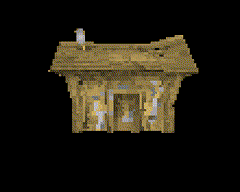
OpenGL is a cross-language, cross-platform application programming interface (API) for rendering 2D and 3D vector graphics. The API is typically used to interact with a graphics processing unit (GPU), to achieve hardware-accelerated rendering.

The High-Level Shader Language or High-Level Shading Language (HLSL) is a proprietary shading language developed by Microsoft for the Direct3D 9 API to augment the shader assembly language, and went on to become the required shading language for the unified shader model of Direct3D 10 and higher.

In computer graphics, a shader is a computer program that calculates the appropriate levels of light, darkness, and color during the rendering of a 3D scene—a process known as shading. Shaders have evolved to perform a variety of specialized functions in computer graphics special effects and video post-processing, as well as general-purpose computing on graphics processing units.

OpenGL for Embedded Systems is a subset of the OpenGL computer graphics rendering application programming interface (API) for rendering 2D and 3D computer graphics such as those used by video games, typically hardware-accelerated using a graphics processing unit (GPU). It is designed for embedded systems like smartphones, tablet computers, video game consoles and PDAs. OpenGL ES is the "most widely deployed 3D graphics API in history".
COLLADA is an interchange file format for interactive 3D applications. It is managed by the nonprofit technology consortium, the Khronos Group, and has been adopted by ISO as a publicly available specification, ISO/PAS 17506.
Mesa, also called Mesa3D and The Mesa 3D Graphics Library, is an open source implementation of OpenGL, Vulkan, and other graphics API specifications. Mesa translates these specifications to vendor-specific graphics hardware drivers.
A shading language is a graphics programming language adapted to programming shader effects. Shading languages usually consist of special data types like "vector", "matrix", "color" and "normal".

Software rendering is the process of generating an image from a model by means of computer software. In the context of computer graphics rendering, software rendering refers to a rendering process that is not dependent upon graphics hardware ASICs, such as a graphics card. The rendering takes place entirely in the CPU. Rendering everything with the (general-purpose) CPU has the main advantage that it is not restricted to the (limited) capabilities of graphics hardware, but the disadvantage is that more transistors are needed to obtain the same speed.

OpenGL Shading Language (GLSL) is a high-level shading language with a syntax based on the C programming language. It was created by the OpenGL ARB to give developers more direct control of the graphics pipeline without having to use ARB assembly language or hardware-specific languages.

The Blender Game Engine was a free and open-source 3D production suite used for making real-time interactive content. It was previously embedded within Blender, but support for it was dropped in 2019, with the release of Blender 2.8. The game engine was written from scratch in C++ as a mostly independent component, and includes support for features such as Python scripting and OpenAL 3D sound.
UNIGINE is a proprietary cross-platform game engine developed by UNIGINE Company used in simulators, virtual reality systems, serious games and visualization. It supports OpenGL 4, Vulkan and DirectX 12.
PSGL is a rendering API available additionally to GCM and OpenGL for Sony's PlayStation 3. PSGL is based on OpenGL ES and Nvidia's CG. A previous version of PSGL was available for the PlayStation 2 but was largely unused.
Randi J. Rost is a computer graphics professional and frequent contributor to graphics standards. He was an early participant in the personal computer industry, creating a game called King Cribbage for the Apple II computer in 1981 and publishing numerous instructional and review articles in trade publications.
HLSL2GLSL is a command line tool and a library that translates shaders written in High Level Shader Language (HLSL) for Direct3D 9 into the OpenGL Shading Language (GLSL).
ARB assembly language is a low-level shading language, which can be characterized as an assembly language. It was created by the OpenGL Architecture Review Board (ARB) to standardize GPU instructions controlling the hardware graphics pipeline.

WebGL is a JavaScript API for rendering interactive 2D and 3D graphics within any compatible web browser without the use of plug-ins. WebGL is fully integrated with other web standards, allowing GPU-accelerated usage of physics, image processing, and effects in the HTML canvas. WebGL elements can be mixed with other HTML elements and composited with other parts of the page or page background.
Stage3D is an Adobe Flash Player API for rendering interactive 3D graphics with GPU-acceleration, within Flash games and applications. Flash Player or AIR applications written in ActionScript 3 may use Stage3D to render 3D graphics, and such applications run natively on Windows, Mac OS X, Linux, Apple iOS and Google Android. Stage3D is similar in purpose and design to WebGL.

Standard Portable Intermediate Representation (SPIR) is an intermediate language for parallel computing and graphics by Khronos Group. It is used in multiple execution environments, including the Vulkan graphics API and the OpenCL compute API, to represent a shader or kernel. It is also used as an interchange language for cross compilation.

Cg and High-Level Shader Language (HLSL) are two names given to a high-level shading language developed by Nvidia and Microsoft for programming shaders. Cg/HLSL is based on the C programming language and although they share the same core syntax, some features of C were modified and new data types were added to make Cg/HLSL more suitable for programming graphics processing units.







